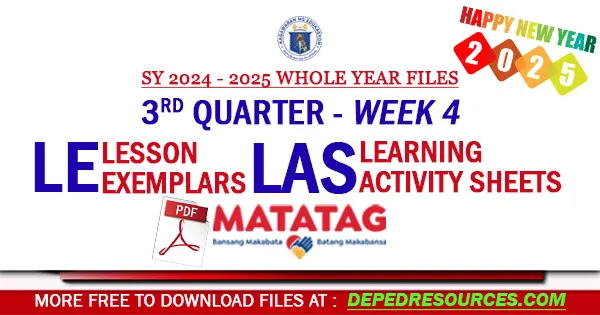Quarter 3 Week 4 Lesson Exemplars (LE) and Learning Activity Sheets (LAS) SY 2024 – 2025
What is a Lesson Exemplar (LE)?
A Lesson Exemplar (LE) is a structured model designed to help teachers transform curriculum standards into practical and effective classroom lessons. These exemplars break down broad educational goals into easy-to-follow plans ensuring that teaching aligns with curriculum requirements and promotes consistent learning outcomes across schools.
Lesson exemplars provide teachers with guidance on how to effectively teach and assess specific topics. They act as a foundation for creating new learning materials, activities and assessments that support student understanding and bridge learning gaps. These tools are especially useful in addressing diverse educational needs.
Lesson exemplars foster collaboration among teachers enabling them to share ideas, improve existing models and develop better teaching strategies together. When designed with cultural relevance in mind, exemplars make lessons more inclusive by reflecting students’ unique backgrounds and experiences. This approach helps create a more engaging and meaningful learning environment.
Lesson exemplars are essential for turning curriculum goals into actionable lessons. They support teachers in delivering aligned, impactful instruction, encourage collaboration and ensure that education is inclusive and relevant for all learners.
What are Learning Activity Sheets (LAS)?
A Learning Activity Sheet (LAS) is a structured resource designed to guide students through lessons in an organized way. While LAS effectively support learning and track progress, they can present challenges. For instance, because students learn at different speeds, a single LAS might not suit everyone. Teachers can address this by creating differentiated LAS to accommodate varying skill levels.
One challenge with LAS is keeping students interested as some may see them as just simple worksheets. To make them more engaging, teachers can incorporate interactive elements like games or creative tasks. This approach transforms LAS into dynamic tools that encourage active learning.
In remote learning settings, limited access to technology can hinder the use of LAS. Providing printed or offline versions ensures all students can participate regardless of their resources. Additionally, teachers should avoid overwhelming students by assigning too many LAS at once which can lead to frustration.
Properly designed LAS strike a balance between structure and flexibility making lessons both effective and engaging. Their adaptability allows them to be used not only in classrooms but also in homes and organizations demonstrating their value in enhancing learning outcomes.

 Learn about the information we collect and how it's used.
Learn about the information we collect and how it's used. Discover how we protect your data.
Discover how we protect your data. Understand your rights and choices regarding your personal information.
Understand your rights and choices regarding your personal information.














